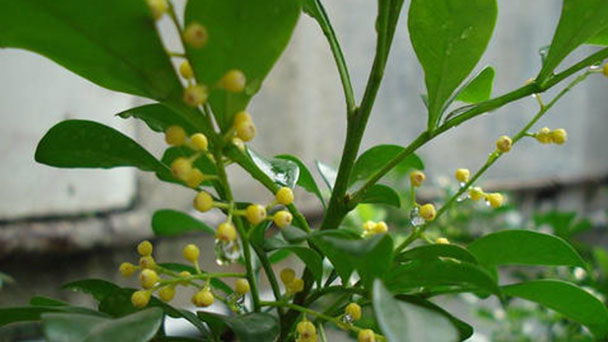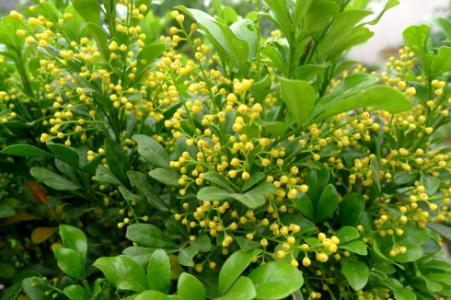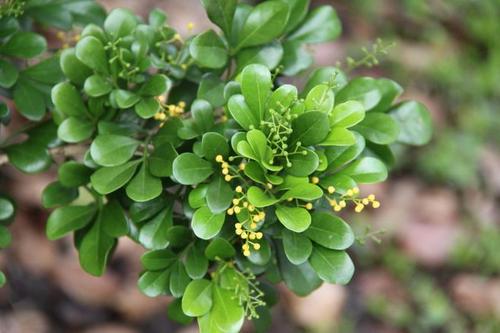Aglaia odorata Lour profile
Written by Maggie
Jan 20 2021

Aglaia odorata Lour. native to South China, it blooms with yellow flowers in summer and autumn. Each branch bears 70-100 small flowers. The flowers are very small, only the size of rice.
Aglaia odorata Lour picture

Morphological characteristics of Aglaia odorata Lour.
Aglaia odorata Lour. is a shrub or small tree; the stem has many small branches, and the top of the young branches is covered with star-shaped rusty scales. The leaf length is 5-12 cm, the leaf shaft and petiole are narrowly winged, with 3-5 leaflets; the leaflets are opposite, thick paper, 2-7 (-11) cm long, 1-3.5 cm wide, with the largest tip , The lower part is much smaller than the apex, the tip is blunt, the base is wedge-shaped, both sides are hairless, the side veins are about 8 on each side, very slender, and the network veins are slightly convex on both sides.
Panicles are axillary, 5-10 cm long, slightly sparsely glabrous; flowers are fragrant, about 2 mm in diameter; pedicels of male flowers are slender, 1.5-3 mm long, pedicels of bisexual flowers are slightly short and thick; calyx is 5-lobed, lobes rounded ; Petals are yellow, oblong or nearly round, 1.5-2 mm long, round and truncated at the top; stamen tube slightly shorter than the petals, obovate or nearly bell-shaped, glabrous outside, full or crenated at the top , Anther 5 are ovate, hidden; ovary ovate, densely covered with yellow shag.
The fruit is a berry, ovate or subglobose, 10-12 mm long, with scattered stellate scales at first, and then shedding; the seeds have fleshy arils. Flowering period is from May to December, fruiting from July to March of the following year.
Growth habits of Aglaia odorata Lour.
Aglaia odorata Lour. Seedlings are more shade-tolerant and positive when they grow up. They like warm and humid climates, but are afraid of cold. They are suitable for being born in fertile, loose, slightly acidic sandy soil rich in humus. aglaia odorata Lour. is very sensitive to low temperature, and a short period of minus low temperature can cause the whole plant to die. When the temperature reaches about 16°C, the plant shoots new branches, but grows slowly and cannot form flower spikes. When the temperature reaches 25°C, the growth is vigorous, and the leaf axils of the new branches give birth to flower spikes.

Distribution of Aglaia odorata Lour.
Aglaia odorata Lour. is produced in Guangdong and Guangxi, China; it is often born in sparse forests or shrubs in low-altitude mountains. It is often cultivated in Fujian, Sichuan, Guizhou, Yunnan and other provinces of China.
The propagating method of Aglaia odorata Lour.
Cutting method
It was carried out from late April to mid-June, and the annual lignified Aglaia odorata Lour. branches were cut. The standard is that the ends of the branches are thick, green in color and full of axillary buds. The cuttings are about 10 cm long, keep 2-3 leaves at the upper end, and remove all other leaves to reduce water evaporation and nutrient consumption, and flatten the cut. The cutting substrate can be vermiculite or coarse sand. When cutting cuttings, first use bamboo chopsticks to make holes with a spacing of about 5 cm, and then insert the cuttings into the holes with a depth of about 1/3 of the cuttings. Press the soil with your fingers to make the soil and cuttings tightly combined, and water enough. Set up shade sheds to maintain a ventilated and humid environment. The rooting speed of cuttings is related to the soil temperature. When the ground temperature is 30-32°C, it can take 40 days after insertion, and it takes 50-60 days to take root at 25°C-28°C.
Layering
It takes place from April to August. Choose annual lignified and robust branches with a stem thickness of 0.5 mm. Cut or peel off the bifurcation at 20 cm, the ring width is about 0.5 cm, and the depth is based on the xylem. Then apply moss or wet soil on the girdling part, wrap the plastic film, and keep the soil ball and moss moist. It takes about two months to take root. Half a year later, it is cut from the mother body and planted separately, and then planted in pots. With this method, the survival rate is high, and the seedlings bloom faster.

Latest Updated
- Benefits of Bugleweed - 7 Science-backed Health Benefits
- Bugleweed Dangers & Side Effects - Is It Poisonous?
- How to Plant Evergreen Trees - What You Should Know
- When to Plant Evergreens - Grow Guide for Evergreen Trees
- 12 Wonderful Evergreen Shrubs for Your Garden
- 12 Popular Evergreen Plants with Pictures for Beginners
- When And How To Prune A Lilac Bush Like a Pro
- How to Grow & Care for Lilac Vine (Hardenbergia Violacea)
- Japanese Lilac Tree (Syringa Reticulata) Care & Propagation Guide
- Shumard Oak Pros and Cons - What to Know
Popular Articles
- Winter maintenance of Antirrhinum Majus
- How to Grow Terminalia Mantaly Tree
- How to Grow and Care for Crossostephium Chinense
- How to grow Antirrhinum Majus in spring
- Peristeria Elata (Dove Orchid) Profile: Info & Care Guide
- Underwatered Snake Plant (Sansevieria Trifasciata) - Signs And How To Fix
- How to Care for Brazilian Jasmine Plant (Mandevilla Sanderi)
- How to Grow & Care for Graptopetalum Purple Delight in Summer
- Rosa Chinensis (China Rose): Plant Growing & Care Tips
- How to Care for Baby Sun Rose (Aptenia Cordifolia)